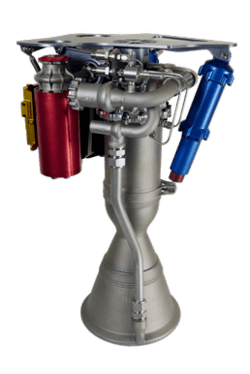Rutherford (rocket engine)
 Sea-level Rutherford engine | |
| Country of origin | New Zealand |
|---|---|
| Designer | Rocket Lab |
| Manufacturer | Rocket Lab |
| Application | First- and second-stage engine |
| Status | In production |
| Liquid-fuel engine | |
| Propellant | LOX[1] / RP-1[1] |
| Cycle | Electric pump-fed engine |
| Pumps | 2 electric pumps |
| Configuration | |
| Chamber | 1 |
| Performance | |
| Thrust | 24kN |
| Thrust (vac.) | 5,400 lbf (24 kN)[1] |
| Thrust (SL) | 5,400 lbf (24 kN)[1] |
| Thrust-to-weight ratio | 68.6 |
| Isp (vac.) |
First stage: 311 s (3.05 km/s) Upper stage: 343 s (3.36 km/s)[2] |
| Dimensions | |
| Dry weight | 35kg |
| Used in | |
| Electron LV | |
| References | |
| References | [3][4][5][6] |
Rutherford is a liquid-propellant rocket engine designed in New Zealand by Rocket Lab[7] and manufactured in the United States.[8] It uses LOX and RP-1 as its propellants and is the first flight-ready engine to use the electric-pump feed cycle. It is used on the company's own rocket, Electron. The rocket uses a similar arrangement to the Falcon 9, a two-stage rocket using a cluster of nine identical engines on the first stage and one, optimized for vacuum operation with a longer nozzle, on the second stage.[5][6] The sea-level version produces 24 kN (5,400 lbf) of thrust and has a specific impulse of 311 s (3.05 km/s), while the vacuum optimized-version produces 24 kN (5,400 lbf) of thrust and has a specific impulse of 343 s (3.36 km/s).[2]
It was qualified for flight in March 2016[9] and had its first flight on 25 May 2017.[10]
Description
Rutherford, named after renowned New Zealand born British scientist Lord Rutherford, is a small liquid-propellant rocket engine designed to be simple and cheap to produce. It is used as both a first-stage and as a second-stage engine, which simplifies logistics and improves economies of scale.[5][6] To reduce its cost, it uses the electric-pump feed cycle, being the first flight-ready engine of such type.[4] It is fabricated largely by 3D printing, using a method called electron-beam melting. Its combustion chamber, injectors, pumps, and main propellant valves are all 3D-printed.[11][12][13]
As with all pump-fed engines, the Rutherford uses a rotodynamic pump to increase the pressure from the tanks to that needed by the combustion chamber.[4] The use of a pump avoids the need for heavy tanks capable of holding high pressures and the high amount of gas needed to pressurize them and replaces them with a pump.[14]
The pumps (one for the fuel and one for the oxidizer) in electric-pump feed engines are driven by an electric motor.[14] The Rutherford engine uses dual brushless DC electric motors and a lithium polymer battery. It is claimed that this improves efficiency from the 50% of a typical gas-generator cycle to 95%.[15] However, the battery pack increases the weight of the complete engine and presents an energy conversion issue.[14]
Each engine has two small motors that generate 50 hp (37 kW) while spinning at 40 000 rpm.[15] The first-stage battery, which has to power the pumps of nine engines simultaneously, can provide over 1 MW of electric power.[16]
The engine is regeneratively cooled, which means that it first passes the fuel through channels that cool the combustion chamber and nozzle before injecting them for combustion.
See also
References
- 1 2 3 4 "Electron". Rocket Lab. Retrieved 24 July 2017.
- 1 2 "Rocket Lab reaches 500 Rutherford engine test fires | Rocket Lab". Rocket Lab. Retrieved 2018-02-01.
- ↑ Brügge, Norbert (11 July 2016). "Asian space-rocket liquid-propellant engines". B14643.de. Retrieved 20 September 2016.
- 1 2 3 "Propulsion". Rocket Lab. Archived from the original on 19 September 2016. Retrieved 19 September 2016.
- 1 2 3 Brügge, Norbert. "Electron NLV". B14643.de. Retrieved 20 September 2016.
- 1 2 3 Brügge, Norbert. "Electron Propulsion". B14643.de. Retrieved 20 September 2016.
- ↑ "Rocket Lab Reveals First Battery-Powered Rocket for Commercial Launches to Space | Rocket Lab". Rocket Lab. Retrieved 2017-05-25.
- ↑ Knapp, Alex (21 May 2017). "Rocket Lab Becomes A Space Unicorn With A $75 Million Funding Round". Forbes. Retrieved 25 May 2017.
- ↑ "Rutherford Engine Qualified for Flight". Rocket Lab. March 2016. Archived from the original on 25 April 2016. Retrieved 19 September 2016.
- ↑ "New Zealand space launch is first from a private site". BBC News. 2017-05-25. Retrieved 2017-05-25.
- ↑ Bradley, Grant (15 April 2015). "Rocket Lab unveils world's first battery rocket engine". The New Zealand Herald. Retrieved 20 September 2016.
- ↑ Grush, Loren (15 April 2015). "A 3D-Printed, Battery-Powered Rocket Engine". Popular Science. Archived from the original on 31 January 2016. Retrieved 20 September 2016.
- ↑ "Propulsion". Rocket Lab. Archived from the original on 10 September 2015. Retrieved 19 September 2016.
- 1 2 3 Rachov, Pablo; Tacca, Hernán; Lentini, Diego (2013). "Electric Feed Systems for Liquid-Propellant Rockets"," (PDF). Journal of Propulsion and Power. AIAA. 29 (5): 1171–1180. doi:10.2514/1.B34714. Retrieved 16 September 2016.
- 1 2 Morring, Jr., Frank; Norris, Guy (14 April 2015). "Rocket Lab Unveils Battery-Powered Turbomachinery". Aviation Week & Space Technology. Archived from the original on 4 March 2016. Retrieved 16 September 2016.
- ↑ "Rocket Lab Introduction" (PDF). Rocket Lab. Archived from the original (PDF) on 20 September 2016. Retrieved 20 September 2016.
